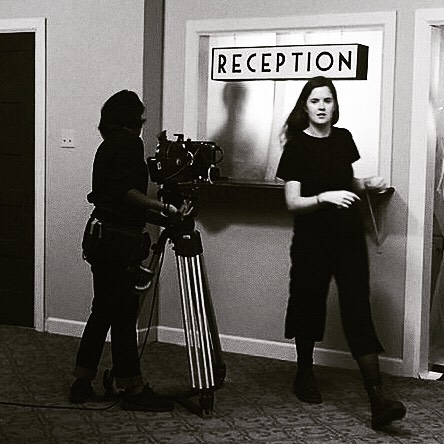
While many cinematographers find their way into the field through photography and other areas of filmmaking, cinematographer Saif Al-Sobaihi, who’s made a powerful name for himself in the U.S. film industry and abroad in recent years, initially found his way to the craft through a love of visual art and design.
“I used to collect a lot of visual books, especially interior design books,” Saif explains. “I just loved looking at the lighting, composition and the smooth design… At that point I had no idea what cinematography was.”
Growing up in Jeddah, Saudi Arabia, Saif immersed himself in design at a young age, swiftly developing an acute visual eye and an unparalleled attention to detail. His boundless creativity even led him to be recognized by his country whilst elementary school when he earned the First Prize Award in the Saudi Arabian national painting competition “Homeland in the Eyes of Our Children.”
Constantly collecting photographs and books focused on visual design, those roots eventually taught him to recognize such things as the interplay of objects in a room, how to achieve an aesthetic balance, and the way the light or lack there of sets the mood, have been key to his success in the film world.
As the cinematographer of highly praised films such as “La Calvita,” “El Circo,” “Pinwheel,” “SKEMO” and others, his unique ability to blend the technical and creative sides of his work in the field of filmmaking shine through flawlessly.
“Some cinematographers are more artistic and others are more technical… To me cinematography is a balance that can’t be defined. It’s a field where creativity, energy, personalities, obstacles, and the importance of timing overlap on set,” explains Saif. “Just like the way harmony in music supports the melody and provides its texture and mood, cinematography supports and even creates the texture and mood within the stories we see on screen.”
Saif has earned extensive accolades for his film work, with “Pinwheel” garnering him two Best Cinematography Awards at the Festigious International Film Festival and the Around International Film Festival in Berlin, “El Circo” earning the Southeast Regional EMMY Award for short form fiction, “La Calvita” being screened as one of “The Coming of Age Mixtape” films chosen by the Bushwick Film Festival, and “SKEMO” being chosen as an Adobe Design Achievement Semifinalist.
“El Circo” director Pablo Ramirez says, “Saif understood perfectly what I had in my head and helped me transform those ideas into beautiful images that showed the organized chaos we wanted to portray… Saif has a unique vision, he has the ability to listen to what his directos want and he also has the sensibility to express himself when he has a different opinion. Saif is one of the most professional persons with whom I’ve had the opportunity to work with.”
While he’s been key to the success of multiple narrative films, Saif actually began his professional career as the cinematographer on the music video “We Are” for well-known Swedish popstar Peg Parnevik. The vivid colors, combination of panning shots and close-ups, as well as the pace of the frames reveal Saif’s unparalleled skill behind the lens.
With nearly two million views on YouTube, the video serves as an impressive accomplishment for even the most seasoned cinematographer, so that says quite a lot considering it was his first professional project in the field.
About the video, which he shot on a RED Scarlet Dragon 6K sensor with Zeiss CP2 primes, Saif says, “I learned a few valuable lessons from this project: lose the ego, keep things simple, and have fun!”
Out of all of his work, Saif marks the 2017 film “La Calvita” directed by Giulia Jimenez as ‘one of the most interesting projects’ he’s been the cinematographer on to date. With the saturated colors, shots of miscellaneous items such as tires, bathroom sinks and other odds and ends riddled through the streets communicating the semi-impoverished nature of the neighborhood, and a storyline that centers on Lupita (Karina Rovira), a young Latin American girl who travels to the Venezuela-Colombia border on a mission to make some money by selling her hair, it’s easy to see from the trailer alone why the film was so interesting for Saif.
In addition to being an Official Selection of the Bushwick Film Festival, “La Calvita” was also an Official Selection of the 2017 Georgia Latino Film Festival and the 2018 San Diego Film Festival.
With an almost surreal visual style, and a transporting latin garage style score composed by Hugo Raúl Blanco, “La Calvita” has a unique appeal that’s reminiscent of of experimental psychedelic films like Alejandro Jodorowsky’s “The Holy Mountain” and Vera Chitlova’s “Daisies.”
One of the most interesting aspects of the film is the way Saif takes us into Lupita’s world through close ups on her face that allow us to truly feel the complexity of her emotions. This, coupled with the wide shots he takes to reveal the peculiar nature of her surrounding, make it feel as though she lives within her own world– one removed from the actual environment where the film takes place.
Saif shot “La Calvita” on a Sony FS7 using only the Cooke 25-250mm T4.0 Zoom as his lens for the entire film.
“As a cinematographer in stories like that where the world seems a bit surreal, you get to experiment with different equipment and techniques more comfortably. And that is a lot of fun,” explains Saif.
“I wanted the look of the film to be gritty and authentic… This film talks about real social issues, so I made sure I captured not only the physical performance of the actors, but their psychological processes and inner world as well. ”
Some of the social issues Saif refers to revolve around Lupita’s economic status and feeling that selling her hair is the only option to make money to pay for her mother’s medication, and the concept of beauty promoted by society compared to what it truly means to be beautiful on an individual level.
After having her hair lopped off in exchange for $35, Lupita wanders through town looking forlorn over the messy buzz cut that sits in place of her previously long and beautiful brown locks. As she runs her fingers through her hair clearly trying to make sense of how this new look has changed her, she encounters a billboard where the model comes to life and begins speaking to her as she stands alone in the middle of a grassy field. The model tells her she wants her to feel better and that she needs hair to feel better; and like a fairy godmother, she releases a waterfall of pink flower petals that graze Lupita’s face and like magic, her hair reappears. From the viewer’s perspective the scene is touching and emotionally subtle, but on a technical level it’s easy to see that a lot of effort went into it on the part of Saif and his team.
“The director wanted the billboard model to be commercially “well-lit” like a 90’s latin billboard commercials kind of vibe. We shot that section in a green screen studio lit with spacelights, Kino Celebs and later on used a Mole Richardson 2K” explains the cinematographer. “My gaffer Dylan Genis rigged the camera on a 12 ft ladder for the high angle shots. For the ‘low angle’ shots, we used baby sticks and hi-hats.”
He adds, “It’s great to have a team who are interested in the project and have good sense of communication and experience.”
Through narrative films like “La Calvita” it’s easy to see Saif’s talent for creating impactful visual stories that draw the audience in and evokes emotion. His attention to detail and his aptitude for blending the technical and creative sides of his work in film make it easy to understand how he got to where he is today, and it all started from his love for visual art and design.















